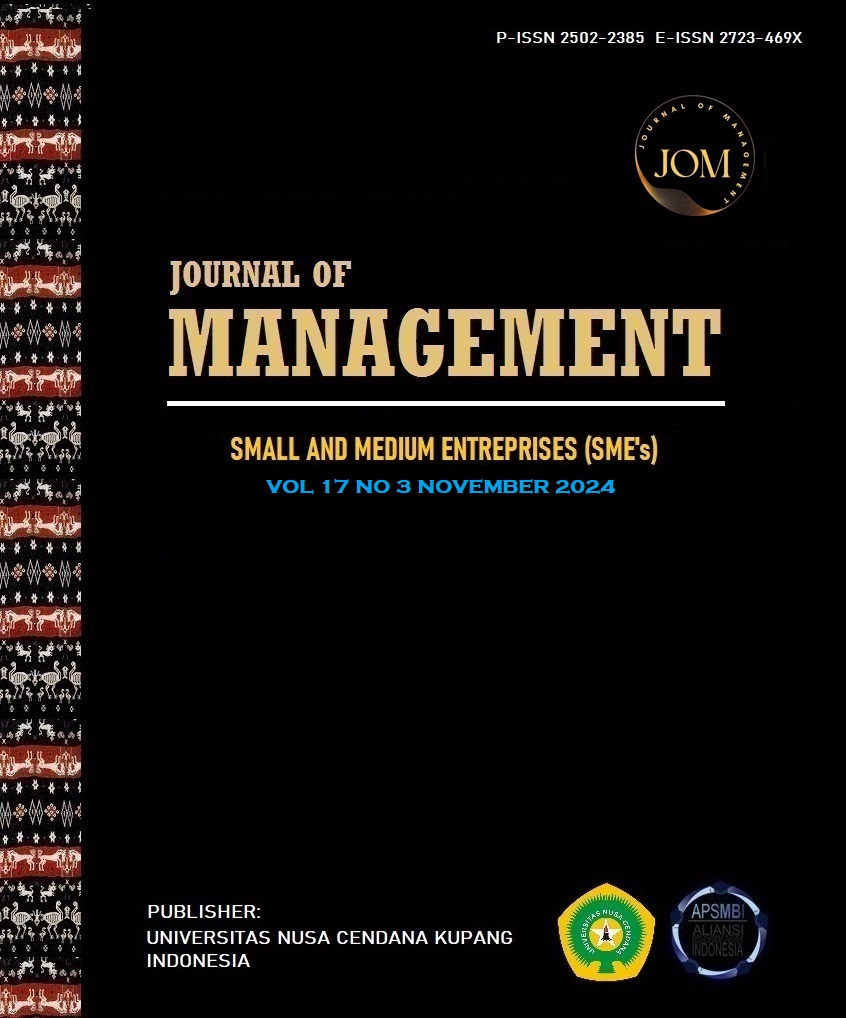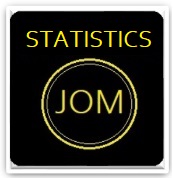ANALISIS PLACE ATTACHMENT DAN FAMILIARITY TERHADAP DESTINATION LOYALTY PADA PENGUNJUNG PANTAI DI KOTA BATAM
Abstract
This study evaluates how place attachment and familiarity influence destination loyalty among beach visitors in Batam. This research was structured based on a quantitative approach to validate the hypotheses that have been suggested. The target population in this research is tourists who visit beaches in Batam. The data collected is then analyzed using statistical analysis techniques such as the t-test. Based on the test, it was found that 50.2% of the influence exerted on the dependent variable came from the independent variable, while the remaining 49.8% resulted from other factors not included in this research model. The conclusions of this research confirm that place attachment and familiarity significantly influence destination loyalty and can be considered critical elements in retaining tourists in the Batam beach destination.
Keywords: Place Attachment; Familiarity; Destination Loyalty
Downloads
References
Afroz, N. N., & Istiaque, A. N. A. (2022). Impact of The Cognitive Image on Destination Loyalty: A Parallel Mediation Technique. Tourism and Sustainable Development Review, 3(1), 45–61. https://doi.org/10.31098/tsdr.v3i1.61
Ariyanto, H., & Ariesty, F. (2017). Peranan citra destinasi dan keakrabandalam meningkatkan loyalitas wisatawan mancanegara di pulau batam. Iptek Terapan, 13(1), 67–74.
Arohman, A., Pranoto, A., Wagiyo, W., Mamusung, R., & Riansyah, A. A. (2024). The Influence Of Brand Familiarity On Purchasing Decisions With Service Quality As A Moderating Variable. Innovative: Journal Of Social Science Research, 4(4), 11478–11489.
Brown, G., Smith, A., & Assaker, G. (2016). Revisiting the host city: An empirical examination of sport involvement, place attachment, event satisfaction and spectator intentions at the London Olympics. Tourism Management, 55, 160–172. https://doi.org/10.1016/j.tourman.2016.02.010
Bujung, F. E., Rotinsulu, D. C., & Niode, A. O. (2019). Pengaruh Jumlah Kunjungan Wisatawan Dan Tingkat Hunian Hotel Terhadap Penerimaan Sektor Pariwisata Sulawesi Utara. Jurnal Berkala Ilmiah Efisiensi, 19(03).
Darma, B. (2021). Statistika Penelitian Menggunakan SPSS (Uji Validitas, Uji Reliabilitas, Regresi Linier Sederhana, Regresi Linier Berganda, Uji t, Uji F, R2). Guepedia.
Dian, N., & Noersanti, L. (2020). Pengaruh Komunikasi, Disiplin, Dan Motivasi Terhadap Kinerja Karyawan Bagian Produksi Pt. Extrupack Bekasi Barat. Sekolah Tinggi Ilmu Ekonomi Indonesia, 3, 1–25.
Ekonomi, P., Iv, P., Komoditas, S., & Madura, U. (2017). Seminar Nasional Seminar Nasional. 225–231.
Febriyanti, D. E., & Arifin, S. (2023). Analisis Strategi Pemasaran Secara Online Melalui Tiktok Dan Instagram Terhadap Volume Penjualan Skincare Justmine Beauty Pada Agen Yuyun Di Lamongan. Neraca: Jurnal Ekonomi, Manajemen Dan Akuntansi, 1(1), 344–352.
Hsu, F. C., & Scott, N. (2020). Food experience, place attachment, destination image and the role of food-related personality traits. Journal of Hospitality and Tourism Management, 44(April), 79–87. https://doi.org/10.1016/j.jhtm.2020.05.010
Ilham. (2020). Hubungan antara penggunaan gadget dengan hasil belajar siswa Kelas V SD Negeri 10 Manurunge Kecamatan Tanete Riattang Kabupaten Bone. Angewandte Chemie International Edition, 6(11), 951–952., 10–27. http://eprints.unm.ac.id/id/eprint/18988
Isdarmanto, I. (2020). Strategi Branding Pengembangan Industri Pariwisata 4.0 melalui Kompetitif Multimedia di Era Digital. Journal of Tourism and Creativity, 4(1), 1–20.
Juliana, J., & Sitorus, N. B. (2022). Kelengkapan Produk Wisata di Pulau Siladen Sebagai Destinasi Wisata Bahari. Khasanah Ilmu-Jurnal Pariwisata Dan Budaya, 13(1), 26–37.
Kapang, S., Rorong, I. P., & Maramis, M. (2019). Analisis Pengaruh Sektor Pariwisata Terhadap Pendapatan Asli Daerah (PAD) Kota Manado. Jurnal Berkala Ilmiah Efisiensi, 19(04), 84–94.
Kurniawati, Y., & Prihandono, D. (2019). Tourist Satisfaction as Mediating Perceived Quality, Push Motivation and Pull Motivation Effect toward Destination Loyalty. Management Analysis Journal, 8(4 SE-Articles).
https://journal.unnes.ac.id/sju/index.php/maj/article/view/34648
Lv, X., Li, C. (Spring), & McCabe, S. (2020). Expanding theory of tourists’ destination loyalty: The role of sensory impressions. Tourism Management, 77(October 2019), 104026. https://doi.org/10.1016/j.tourman.2019.104026
Megawati, H., & Maulana, H. (2024). Psikologi Komunitas: Peran Aktif Psikologi Untuk Masyarakat. Bumi Aksara.
Minarti, S. (2022). Ilmu Pendidikan Islam: Fakta teoretis-filosofis dan aplikatif-normatif. Amzah.
Muis, M. R., Gultom, D. K., Jufrizen, J., & Azhar, M. E. (2020). Model Elektronik Word of Mouth: Citra Destinasi, Kepuasan dan Loyalitas Wisatawan. Jurnal Ilmiah Manajemen Dan Bisnis, 21(1), 1–19.
Mutia, I. M., Sukamdani, N. B., & Sukwika, T. (2021). Analisis Kesiapan Maxone Hotels Tidar Surabaya Menghadapi Covid-19 di Tinjau Dari Tingkat Loyalitas dan Kinerja Karyawan. Journal of Applied Management Research, 1(2), 101–108.
Nilplub, C., Khang, D. B., & Krairit, D. (2016). Determinants of destination loyalty and the mediating role of tourist satisfaction. Tourism Analysis, 21(2), 221–236. https://doi.org/10.3727/108354216X14559233984818
Nopriyanto, A. (2024). Analisis Pengaruh Corporate Social Responsibility (Csr) Terhadap Nilai Perusahaan. Komitmen: Jurnal Ilmiah Manajemen, 5(2), 1–12.
Nursanty, E., & Wulandari, A. (2021). Place Attachment: Research dedicated to defining what makes a place" meaningful" enough for place attachment. Butterfly Mamoli Press.
Nyoko, A. E., & Fanggidae, A. H. (2015). The Design Of Local Wisdom-Based Ecotourism Destination In Kupang City. Journal of Management: Small and Medium Enterprises (SMEs), 1(1), 103-118.
Pandiangan, K., Masiyono, M., & Atmogo, Y. D. (2021). Faktor-faktor yang mempengaruhi brand equity: brand trust, brand image, perceived quality, & brand loyalty. Jurnal Ilmu Manajemen Terapan, 2(4), 471–484.
Prayogo, N. S., Kunto, Y. S., Raharja, M. S., Eleison, N. P. G. K., & Budiono, A. G. (2024). Pengaruh Brand Familiarity dan Perceived Nostalgia Terhadap Post-Purchase Intention Jajan Tradisional Srabi Notosuman Pada Generasi
Millennial dan Gen Z. Jurnal Manajemen Pemasaran, 18(1), 58–68.
Rachmadi, H. (2020). Model pengambilan keputusan berwisata. Media Wisata, 14(2).
Rahma, A. A. (2020). Potensi sumber daya alam dalam mengembangkan sektor pariwisata di Indonesia. Jurnal Nasional Pariwisata, 12(1), 1–8.
Risfandini, A. (2022). Promotion and development strategy for 5 prioritized tourist attraction in Kotabaru Regent. Jurnal Pariwisata Pesona, 7(1), 75–84.
Roostika, R. (2012). Citra Merek Tujuan Wisata Dan Perilaku Wisatawan: Yogyakarta Sebagai Daerah Tujuan Wisata. Jurnal Manajemen Dan Akutansi, 1(1), 41–54.
Sari, M. S., & Zefri, M. (2019). Pengaruh Akuntabilitas, Pengetahuan, dan Pengalaman Pegawai Negeri Sipil Beserta Kelompok Masyarakat (Pokmas) Terhadap Kualitas Pengelola Dana Kelurahan Di Lingkungan Kecamatan Langkapura. Jurnal Ekonomi, 21(3), 311.
Stylos, N., Vassiliadis, C. A., Bellou, V., & Andronikidis, A. (2016). Destination images, holistic images and personal normative beliefs: Predictors of intention to revisit a destination. In Tourism Management (Vol. 53). https://doi.org/10.1016/j.tourman.2015.09.006
Suntoro, W., & Silintowe, Y. B. R. (2020). Analisis pengaruh pengalaman merek, kepercayaan merek, dan kepuasan merek terhadap loyalitas merek. Modus, 32(1), 25–41.
Suriani, N., Risnita, & Jailani, M. S. (2023). Konsep Populasi dan Sampling Serta Pemilihan Partisipan Ditinjau Dari Penelitian Ilmiah Pendidikan. Jurnal IHSAN : Jurnal Pendidikan Islam, 1(2), 24–36. https://doi.org/10.61104/ihsan.v1i2.55
Tsarashafa, T. A., & Qastharin, A. R. (2021). How Fashion Influencer Contributes To Consumers’ Purchase Intention of University Student. Advanced International Journal of Business, Entrepreneurship and SMEs, 3(9), 209–227. https://doi.org/10.35631/aijbes.39015
Ulfitriana, U., Dewi, N. Y. S., Agustina, A., Hidayanti, N. F., & Ariani, Z. (2024). Peran Media Sosial dalam Membentuk Tren Pariwisata Kuliner: Studi Kasus Food Blogger dan Influencer. Seminar Nasional Paedagoria, 4(1), 96–107.
Widodo, E., Pramitasari, D., & Marcillia, S. R. (2019). Place Attachment Abdi Dan Masyarakat Terhadap Puri Ubud Di Kabupaten Gianyar, Bali. Nature: National Academic Journal of Architecture, 6(2), 162–176.
Xu, J., & Han, R. (2019). The influence of place attachment on pro-environmental behaviors: The moderating effect of social media. International Journal of Environmental Research and Public Health, 16(24).
https://doi.org/10.3390/ijerph16245100

 Dame Afrina Sihombing(1*)
Dame Afrina Sihombing(1*)



